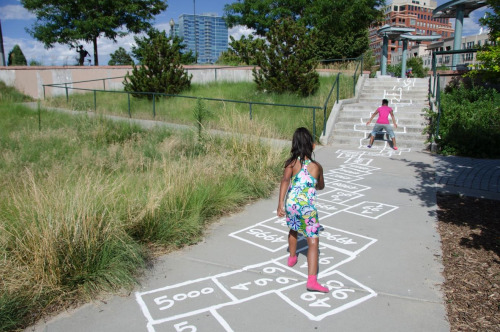Placing Art at People’s Feet: Redline Explores Play for Summer Exhibition
12th August 2015

While the summer sun has been pouring down in Denver, you may have noticed the painted hopscotch course dotting the streets over the last couple of weeks. Seven sites across the city of Denver, in various neighborhoods, were chosen by artist Agustina Woodgate as part of a public art installation in conjunction with the Biennial of the Americas. The hopscotch course served as a visible chain linking neighborhoods across the city and invited Denver residents to set aside their normal routine and hop to their destination. It’s summer after all, let’s play!
Each hopscotch course started and ended at a storm drain and was a continuation from the previous cities involved in the installation including Bueno Aries, Miami, Portland and Brooklyn. The hopscotch course started at 1 and ended in Denver at just over 5000, meaning the artist and the communities across the world have helped in painting over 5000 squares.
In executing the project, the artist Agustina Woodgate, engaged communities on site. She spent time working with the children’s museum promoting the project, and other community organizations, linking the city and breaking typical neighborhood silos. And because the project has a global reach, the project connects not only communities within cities, but cities to a larger global network. This connectivity is a theme permeating contemporary artistic expression.
Redline was founded by Laura Merage, an artist and philanthropist and seeks to provide an environment where artists can grow and experiment at early or mid stages of their career. The main exhibition space is surrounded by artist studios which are provided to artists free of charge for two years. The gallery has a community focus, seeking to break down the metaphorical “red line” that prevents people from exploring their own creativity.
The hopscotch exhibit is part of a larger show called Playgrounds, on view until August 16 at Redline, which focuses on artwork that engages in concepts of play. As part of the exhibit, artist Dan Tobin Smith, a still life commercial photographer has meticulously laid out color coordinated objects which appear to be taken from a junk yard. The artist’s commentary is on the space that we occupy and the stuff we surround ourselves with, a concept sometimes referred to as Kipple, coined by science fiction writer Philip K. Dick. The artist has over 66 boxes of color-coordinated objects he ships around the country from his base in London.
Another global artist, Cuban American Tony Labat presented a conceptual piece which is a commentary on Cuban culture and its interaction with the US. The exhibit consists of a pool table in the shape of Cuba placed in front of a set of bleachers. In Cuba, pool is not permitted, but because the piece was considered interactive art, the viewers were able to participate and play the game in his home country as part of artistic appreciation. In addition, the placement of the bleachers signaled the position the United States takes towards Cuba, and the state of current affairs in the country. He wanted to create a visual allegory to the feeling Cubans feel of being watched and tracked by the US.
The pool table exhibit has perhaps the clearest tie in to the Biennial, which explores relationships between Latin America and the United States, but the whole exhibit was curated with the Biennial in mind. Curators Ruth Bruno and Corney Lane Stell were looking to “turn common interactions and attitudes towards familiar spaces on their head” through the exhibition.
Ultimately, the goal of Redline is to push people’s mental boundaries about what art is and how it is capable of making change in communities. And a big role of contemporary art is to open the door to a dialog about various aspects of our culture we may observe, but rarely get a chance to talk about with others or reflect on in a communal setting. But getting people into art spaces can be a challenge. The hopscotch project literally places the art at people’s feet, hoping to start that dialog.
1 Notes
 umadokabro likes this
umadokabro likes this innovatorspeak posted this
innovatorspeak posted this
